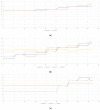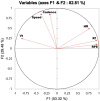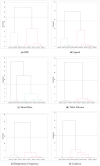Oxygen Uptake Measurements and Rate of Perceived Exertion during a Marathon
- PMID: 35565153
- PMCID: PMC9104840
- DOI: 10.3390/ijerph19095760
Oxygen Uptake Measurements and Rate of Perceived Exertion during a Marathon
Abstract
Although the marathon race has been democratized, it remains complex due to the famous "hitting the wall" phenomenon after the 25th km. To characterize this "wall" from a physiological and Rate of Perceived Exertion (RPE) perspective in recreational marathon runners, we report first continuous breath-by-breath gas exchange measurements during an actual marathon race. In order to test the hypothesis that RPE could be a candidate for controlling the marathon pace, this study examined the relationship between RPE and the physiological variables time course throughout a marathon. Only the respiratory frequency and heart rate increased progressively during the race in all the runners, while the oxygen uptake and ventilatory rate followed different kinetics according the individuals. However, the indexation of the physiological parameters and speed by RPE showed the same decreased tendency for all the runners. In conclusion, these results suggest that running a marathon must be self-paced with the RPE.
Keywords: cardiovascular drift; endurance running; hitting the wall; physiology of exercise; positive split; self-pace.
Conflict of interest statement
The authors declare no conflict of interest.
Figures






Similar articles
-
Heart Rate Does Not Reflect the %VO2max in Recreational Runners during the Marathon.Int J Environ Res Public Health. 2022 Sep 29;19(19):12451. doi: 10.3390/ijerph191912451. Int J Environ Res Public Health. 2022. PMID: 36231750 Free PMC article.
-
Correlation Properties of Heart Rate Variability during a Marathon Race in Recreational Runners: Potential Biomarker of Complex Regulation during Endurance Exercise.J Sports Sci Med. 2021 Oct 1;20(4):557-563. doi: 10.52082/jssm.2021.557. eCollection 2021 Dec. J Sports Sci Med. 2021. PMID: 35321146 Free PMC article.
-
Test-Retest Reliability of Running Economy and Other Physiological Parameters During 90 min of Running in Well-Trained Male Endurance Runners.Scand J Med Sci Sports. 2025 Jun;35(6):e70080. doi: 10.1111/sms.70080. Scand J Med Sci Sports. 2025. PMID: 40421635 Free PMC article.
-
Tactical behavior of high-level male marathon runners.Scand J Med Sci Sports. 2021 Mar;31(3):521-528. doi: 10.1111/sms.13873. Epub 2020 Nov 26. Scand J Med Sci Sports. 2021. PMID: 33179319 Review.
-
Applied physiology of marathon running.Sports Med. 1985 Mar-Apr;2(2):83-99. doi: 10.2165/00007256-198502020-00002. Sports Med. 1985. PMID: 3890068 Review.
Cited by
-
Fractal correlation properties of heart rate variability and respiratory frequency as measures of endurance exercise durability.Eur J Appl Physiol. 2025 Jun;125(6):1619-1631. doi: 10.1007/s00421-025-05716-2. Epub 2025 Feb 4. Eur J Appl Physiol. 2025. PMID: 39904800
-
A Pilot Study Using Entropy for Optimizing Self-Pacing during a Marathon.Entropy (Basel). 2023 Jul 26;25(8):1119. doi: 10.3390/e25081119. Entropy (Basel). 2023. PMID: 37628149 Free PMC article.
-
Heart Rate Does Not Reflect the %VO2max in Recreational Runners during the Marathon.Int J Environ Res Public Health. 2022 Sep 29;19(19):12451. doi: 10.3390/ijerph191912451. Int J Environ Res Public Health. 2022. PMID: 36231750 Free PMC article.
-
Brain, Metabolic, and RPE Responses during a Free-Pace Marathon: A Preliminary Study.Int J Environ Res Public Health. 2024 Aug 3;21(8):1024. doi: 10.3390/ijerph21081024. Int J Environ Res Public Health. 2024. PMID: 39200635 Free PMC article.
References
-
- Run Repeat. [(accessed on 9 March 2022)]. Available online: https://runrepeat.com/state-of-running.
-
- Latta S. Hitting the wall: If you understand the scientific reasons behind “the wall”, you should be able to avoid it. Marathon Beyond. 2003;7:61–72.
-
- Berndsen J., Lawlor A., Smyth B. Exploring the Wall in Marathon Running. J. Sport. Anal. 2020;6:173–186. doi: 10.3233/JSA-200354. - DOI
-
- Smyth B. Fast Starters and Slow Finishers: A Large-Scale Data Analysis of Pacing at the Beginning and End of the Marathon for Recreational Runners. J. Sport. Anal. 2018;4:229–242. doi: 10.3233/JSA-170205. - DOI
MeSH terms
Substances
LinkOut - more resources
Full Text Sources

